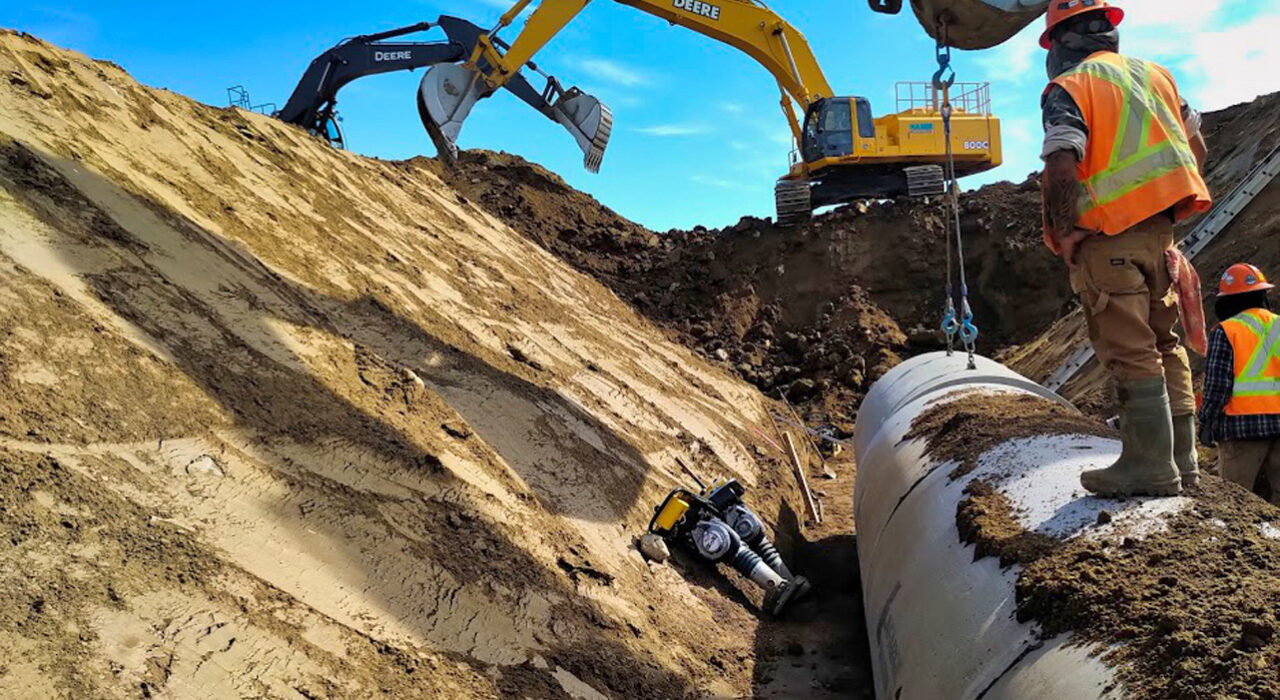

Articles
How To Determine Who Owns A Fence
Modified: December 7, 2023
Learn how to determine the ownership of a fence with our informative articles. Find out who is responsible for maintenance and boundaries.
(Many of the links in this article redirect to a specific reviewed product. Your purchase of these products through affiliate links helps to generate commission for Storables.com, at no extra cost. Learn more)
Introduction
When it comes to determining the ownership of a fence, things can get a bit tricky. Property boundaries can be ambiguous, and the legal aspects surrounding ownership can be complex. However, if you find yourself in a situation where you need to know who owns a fence, there are several steps you can take to find the answer.
In this article, we will explore various methods you can use to determine who owns a fence. From understanding property boundaries to researching previous property owners, we will provide you with the information you need to navigate this often confusing issue. So, let’s get started!
Understanding Property Boundaries
The first and most important step in determining fence ownership is to understand property boundaries. Property boundaries are lines that define where one property ends and another begins. These boundaries are typically established through legal documents and surveys.
To gain a better understanding of your property boundaries, you can refer to your property deed or plat map. These documents outline the property lines and can help you determine who owns the fence based on its location relative to your property.
Assessing Property Records
Besides consulting your property deed or plat map, it is also crucial to assess the property records. These records can provide valuable information regarding the ownership of the fence.
You can contact your local tax assessor’s office or land records office to request the property records. These records typically include information about the previous and current property owners, which can help you determine who owns the fence.
Researching Previous Property Owners
If the property records do not provide a clear answer, you can delve deeper into researching previous property owners. This can be particularly useful if the fence has been in place for a long time and the current owner is uncertain about its origins.
You can start by conducting a title search. A title search involves examining the chain of ownership of the property over time. By reviewing the property’s title history, you may uncover information about who installed or owned the fence in the past.
Analyzing Local Regulations and Ordinances
In some cases, local regulations and ordinances may provide guidelines on fence ownership. Zoning laws, homeowner association rules, and local building codes can determine who is responsible for maintaining and owning the fence.
Researching and understanding these regulations can help you determine who owns the fence based on the specific guidelines set forth in your area.
Consulting with Neighbors
…
Key Takeaways:
- Understanding property boundaries and researching property records are crucial steps in determining fence ownership. Consulting with neighbors and hiring a land surveyor can provide valuable insights and official evidence to resolve ownership disputes.
- Open communication, collaboration, and, if necessary, legal action are essential in resolving fence ownership disputes. Seeking legal advice and maintaining respectful dialogue with neighbors can lead to a satisfactory resolution.
Read more: Who Owns A Fence On A Property Line
Understanding Property Boundaries
When it comes to determining the ownership of a fence, understanding property boundaries is crucial. Property boundaries are the lines that define where one property ends and another begins. These boundaries are typically established through legal documents and surveys.
To gain a better understanding of your property boundaries, you can refer to your property deed or plat map. Your property deed is a legal document that outlines the boundaries of your property and can provide valuable information about the ownership of the fence. A plat map, on the other hand, is a detailed map that shows the boundaries of individual properties within a larger area.
By examining your property deed or plat map, you can determine the location of the fence relative to your property. If the fence is entirely within your property boundaries, you are likely the owner. However, if the fence is situated on the boundary line between two properties, ownership may be shared between you and your neighbor.
In some cases, property boundaries may not be clearly marked or easily identifiable. This can occur when there are no physical markers or when the property has undergone changes over time. If you are unsure about the exact location of your property boundaries, you may need to consult a land surveyor to conduct a survey. A land surveyor will measure and map out the boundaries of your property, providing you with precise information regarding fence ownership.
It’s important to note that property boundaries can be subject to legal disputes and disagreements between neighbors. If you find yourself in a situation where the exact location of your property boundaries is in question, it may be necessary to consult with an attorney or mediator to help resolve the issue.
In addition to property deeds and surveys, local laws and regulations can also play a role in determining fence ownership. Zoning laws, homeowner association rules, and local building codes may provide guidelines on fence ownership and maintenance responsibilities. Researching and understanding these regulations can help you determine who owns the fence based on the specific guidelines set forth in your area.
Overall, understanding property boundaries is a crucial step in determining fence ownership. By examining property deeds, plat maps, and consulting with professionals when necessary, you can gain clarity on who owns the fence and navigate any potential disputes or disagreements with your neighbors.
Assessing Property Records
When trying to determine who owns a fence, assessing property records can provide valuable information. Property records are official documents that contain details about a property’s ownership history, including previous and current owners.
To access property records, you can start by contacting your local tax assessor’s office or land records office. These government offices maintain records related to property ownership, transfers, and assessments. They can provide you with documents such as property tax records, deeds, and surveys.
Property tax records can be particularly helpful, as they often include the names of the current property owners and sometimes the address of the property. By comparing this information with the location of the fence, you may be able to determine the owner of the fence.
In addition to property tax records, deeds are another important document to examine. A property deed is a legal document that transfers ownership of a property from one person or entity to another. By reviewing the deed, you can gather important details about the chain of ownership and any previous transfers that may shed light on the fence’s ownership.
Surveys are also valuable documents for assessing property records. A land survey is a professional assessment that determines the precise boundaries and dimensions of a property. It can provide accurate information about the location of the fence in relation to the property lines. If the fence overlaps with your property according to a survey, it could indicate ownership on your part.
It’s important to note that accessing property records may not always be a straightforward process. Some jurisdictions may require you to submit a request, provide identification, or pay a fee to obtain these records. However, the information contained within property records can provide important insights into the ownership of the fence.
In some cases, the property records may not directly answer the question of fence ownership. For example, if the fence has been in place for a long time, the current owner may not be aware of who installed it or when it was built. In such scenarios, it may be necessary to conduct further research, such as examining historical records or reaching out to previous property owners.
By diligently assessing property records and gathering relevant documents, you can piece together the puzzle of fence ownership. Remember to consult with professionals, such as land surveyors or attorneys, if you encounter challenges or need further assistance in interpreting the information from property records.
Researching Previous Property Owners
When trying to determine who owns a fence, researching previous property owners can provide valuable insights. This is especially useful if the fence has been in place for a considerable amount of time or if the current owner is uncertain about its origins.
One of the initial steps you can take is to conduct a title search. A title search involves examining the chain of ownership of the property over time. This can be done by accessing public records or hiring a title company to conduct the search on your behalf. The purpose of a title search is to determine the history of ownership and any potential transfers that may have occurred.
During the title search, you may come across documentation that mentions the fence. This could include old surveys, property descriptions, or even permits for fence installation. By reviewing these historical documents, you may be able to trace back the ownership of the fence to previous property owners.
Additionally, speaking with long-time residents or neighbors in the area can provide valuable information. They may have knowledge about the fence’s installation or previous owners who may have mentioned it. Local historical societies or community organizations can also be helpful resources for gathering information about the history of the property and any notable features like the fence.
Another avenue to explore is researching public records related to the property. These records can include building permits, property inspection reports, or any legal documentation related to the fence. Such records can provide clues about when the fence was constructed and who may have been responsible for its installation.
If you are unable to find conclusive evidence about the ownership of the fence through your research, consider reaching out to previous property owners. The current property owner may have contact information or be able to assist in locating past owners. By contacting previous owners, you can gather firsthand knowledge about the fence and potentially uncover information that clarifies its ownership.
In some cases, researching previous property owners may reveal that the ownership of the fence has changed hands multiple times. This can complicate matters, but by gathering as much information as possible, you can piece together a clearer picture of the fence’s ownership history.
Keep in mind that researching previous property owners requires time, effort, and potentially access to various documents and sources. It can be a multi-step process that may involve delving into records or speaking with multiple individuals. However, by being thorough in your research, you can uncover valuable information that helps determine the ownership of the fence.
Analyzing Local Regulations and Ordinances
Local regulations and ordinances can play a significant role in determining fence ownership. Zoning laws, homeowner association rules, and local building codes often provide guidelines regarding fence installation, maintenance, and ownership responsibilities.
The first step in analyzing local regulations is to review the zoning laws in your area. Zoning laws typically dictate how properties can be used and what structures are allowed. They may specify the location, height, and materials permitted for fences within different zones. By understanding these regulations, you can determine if there are any specific rules regarding fence ownership.
Homeowner associations (HOAs) are another important consideration. If your property is part of an HOA, there may be specific rules and guidelines that govern fence ownership and maintenance. These rules can vary widely, so it’s essential to obtain a copy of the HOA’s bylaws or covenants and carefully review them to understand the responsibilities of fence ownership.
Local building codes may also provide insights into fence ownership. Building codes outline the minimum standards for construction and safety in a specific jurisdiction. Some building codes may specify that the property owner on which the fence structure stands is responsible for maintenance and ownership.
In addition to zoning laws, HOA rules, and building codes, it’s important to consider any historical preservation regulations in your area. If your property is in a designated historic district or has historical significance, there may be additional rules or permits required for fence installation or alterations.
Researching and analyzing the local regulations and ordinances involving fence ownership can help you determine who is responsible for maintaining and owning the fence. It’s crucial to consult the official documents directly, as interpretations or informal understandings may not be accurate or legally binding.
If you have any questions or concerns about the local regulations or ordinances, it’s advisable to consult with a legal professional or reach out to the appropriate local government department for clarification. They can provide guidance and help you navigate the complexities of the regulations to determine the rightful ownership of the fence.
Remember that local regulations and ordinances can vary from one jurisdiction to another. So, what may apply in one area may not be the same in another. Taking the time to understand the specific rules and guidelines in your locality will ensure that you are approaching the issue of fence ownership with the correct information.
Check your property deed or survey to see if it indicates who owns the fence. If not, try to find any previous agreements or documents related to the fence ownership. If all else fails, consider discussing the issue with your neighbor and coming to a mutual agreement.
Read more: Who Owns Sealy Mattress
Consulting with Neighbors
When it comes to determining the ownership of a fence, consulting with your neighbors can be a helpful step in gathering information and potentially resolving any uncertainties or disputes. Your neighbors may have knowledge or insights that can assist you in determining who owns the fence.
Approaching your neighbors with a friendly and respectful attitude is important. Start by initiating a conversation and explaining your reason for inquiring about the fence ownership. Be open and honest about your intentions to resolve any questions or concerns.
Your neighbors may have firsthand knowledge about the installation or maintenance of the fence. They may have information about the previous property owners or any agreements made regarding the fence. By sharing their knowledge and experiences, they can help shed light on the fence’s history and ownership.
It’s essential to approach the conversation without making assumptions or accusations. Remember that your neighbors may not be aware of the legalities surrounding fence ownership or may have different perspectives. Maintain a respectful dialogue and listen to their input to gain a comprehensive understanding of the situation.
If your neighbors are receptive, you may even consider collaborating on finding a resolution. This could involve researching historical records, sharing the cost of a land survey, or consulting with legal professionals to settle any ownership disputes.
In some cases, your neighbors may not have the information or clarity needed to determine fence ownership. However, engaging in open communication can help foster a sense of transparency and may lead to a collaborative effort in finding a resolution.
Keep in mind that while it can be helpful to consult with your neighbors, their knowledge or opinions should not be the sole determining factor in establishing fence ownership. It’s important to gather additional evidence and consult official documents, such as property deeds, surveys, and local regulations, to confirm ownership.
If there is a disagreement or dispute with your neighbors regarding fence ownership, it may be necessary to involve a mediator or seek legal guidance to find a resolution. Mediation can help facilitate a constructive conversation and potentially arrive at a mutually agreeable solution. Legal advice can provide clarity on local laws, regulations, and rights related to fence ownership.
In summary, consulting with your neighbors can be a valuable step in determining fence ownership. Their knowledge and insights may provide helpful information, but it’s important to combine their input with other sources of evidence. Maintain open and respectful communication throughout the process, and seek professional advice if needed, to resolve any uncertainties or disputes regarding fence ownership.
Hiring a Land Surveyor
When it comes to determining fence ownership, hiring a land surveyor can provide definitive answers regarding property boundaries and the specific ownership of the fence. A land surveyor is a trained professional who specializes in measuring and mapping land.
By hiring a land surveyor, you can obtain an accurate assessment of your property boundaries and the location of the fence in relation to those boundaries. This can help determine who owns the fence and resolve any disputes or uncertainties.
Land surveyors use specialized equipment and techniques to conduct surveys. They may use a combination of historical records, maps, and physical measurements to establish property boundaries and meticulously map out the precise location of the fence.
When hiring a land surveyor, it is essential to choose a qualified and reputable professional. You can start by researching surveyors in your area and checking for proper licensing and certifications. Look for individuals or firms with experience in property boundary disputes or fence ownership matters.
Once you have identified potential surveyors, contact them to discuss your specific needs and request a cost estimate. The price of a survey can vary depending on factors such as the size of the property, complexity of the boundaries, and the location of the fence.
During the surveying process, it may be necessary for the land surveyor to access your property and neighboring properties to gather accurate data. This may involve conducting field measurements, taking photographs, and examining any existing documents related to the property.
After completing the survey, the land surveyor will provide you with a detailed report that outlines the property boundaries and the location of the fence. This report can serve as official evidence of the fence ownership and can be used to resolve any disputes or uncertainties.
It’s important to note that the survey report is a legally binding document. Therefore, it is wise to keep it in a safe place and provide copies to any relevant parties, such as neighbors or legal professionals, as needed.
Hiring a land surveyor can be particularly beneficial in cases where property boundaries are not clearly defined or when there are disagreements about fence ownership. The professional expertise and precise measurements provided by a surveyor can help settle any disputes and establish a clear understanding of who owns the fence.
Remember that the cost of hiring a land surveyor may be an investment in resolving fence ownership issues and avoiding potential conflicts in the future. By obtaining an official survey report, you can have peace of mind and clarity regarding the accurate ownership of the fence.
Resolving Disputes and Legal Actions
While it is ideal to amicably resolve fence ownership disputes with your neighbors, there may be instances where disagreements persist. In such cases, it may be necessary to take legal action to establish the rightful ownership of the fence.
Here are some steps to consider when resolving disputes and taking legal action:
1. Consult with an Attorney: If you find yourself in a stalemate or facing complex legal issues regarding fence ownership, it is advisable to seek the guidance of an attorney specializing in property law. They can provide you with legal advice, assess your case, and guide you through the legal process.
2. Gather Evidence: Collect any relevant documents, such as property deeds, surveys, photographs, or communications with your neighbors, that support your claim to fence ownership. This evidence will strengthen your case when presenting it to your attorney and during any potential legal proceedings.
3. Mediation: Prior to pursuing legal action, consider engaging in mediation. Mediation involves a neutral third party who facilitates a conversation between you and your neighbors to help find a mutually agreeable solution. This can be a time and cost-effective approach to resolving disputes without escalating the matter to court.
4. File a Lawsuit: If mediation fails or is not a viable option, filing a lawsuit may be necessary to resolve the dispute. Your attorney can assist you in preparing the necessary legal documents, such as a complaint or petition, which outline your claim for fence ownership. The legal process may involve hearings, presenting evidence, and court proceedings.
5. Adverse Possession: In some cases, adverse possession laws may come into play. Adverse possession allows someone who has openly and continuously occupied or used another person’s property without permission to potentially gain ownership after a certain period of time. However, adverse possession laws vary by jurisdiction and require specific criteria to be met.
6. Court Decision: If the fence ownership dispute goes to court, a judge will hear both sides of the case and make a decision based on the evidence and applicable laws. It is essential to present your evidence clearly and persuasively, and your attorney will represent your interests throughout the legal process.
7. Final Resolution: Once a decision is reached by the court, it becomes legally binding. The court’s ruling will clarify the ownership of the fence and establish the responsibilities of each party regarding maintenance, repairs, and any other relevant factors.
Remember, legal processes can be time-consuming, costly, and emotionally draining. It is crucial to weigh the potential outcomes and consider alternative dispute resolution methods before proceeding with legal action. Open communication, cooperation, and a willingness to find a resolution are often the most desirable outcomes when dealing with fence ownership disputes.
Ultimately, resolving disputes and taking legal action should only be considered as a last resort when all other attempts at resolution have been unsuccessful. It is always advisable to seek legal advice from a professional who can guide you through the specific legal procedures and provide the appropriate support during the process.
Conclusion
Determining fence ownership can be a complex and sometimes contentious issue. However, by following the steps outlined in this article, you can navigate through the process and find a resolution.
Understanding property boundaries, assessing property records, researching previous property owners, analyzing local regulations and ordinances, consulting with neighbors, hiring a land surveyor, and, if necessary, resolving disputes through legal actions are all important steps to determine who owns a fence.
Property deeds, plat maps, tax records, and historical documentation can provide valuable information about the ownership of the fence. Consulting with neighbors can offer firsthand insights, while local regulations and ordinances can offer guidelines for fence ownership responsibilities.
In cases where uncertainty persists, hiring a land surveyor can provide accurate and official information about property boundaries and the location of the fence. This can be crucial in settling ownership disputes.
When disputes between neighbors arise, open communication and collaboration are key. Consulting with neighbors and engaging in mediation can often lead to mutually agreed-upon solutions.
In situations where resolution cannot be reached, legal actions may be necessary. Consultation with an attorney who specializes in property law can help you understand your rights and guide you through the legal process.
Ultimately, the specific steps to determining fence ownership will vary depending on the circumstances, local regulations, and the willingness of all parties involved to work towards a resolution.
Remember, communication, respect, and understanding are essential throughout this process. By approaching the issue with empathy and a willingness to find common ground, you can increase the likelihood of a satisfactory outcome and maintain positive relationships with your neighbors.
In conclusion, determining who owns a fence may require a combination of research, documentation, legal guidance, and open dialogue. By following the steps outlined in this article, you can navigate the complexities of fence ownership and gain the clarity you need to address any disputes or uncertainties.
Frequently Asked Questions about How To Determine Who Owns A Fence
Was this page helpful?
At Storables.com, we guarantee accurate and reliable information. Our content, validated by Expert Board Contributors, is crafted following stringent Editorial Policies. We're committed to providing you with well-researched, expert-backed insights for all your informational needs.















0 thoughts on “How To Determine Who Owns A Fence”